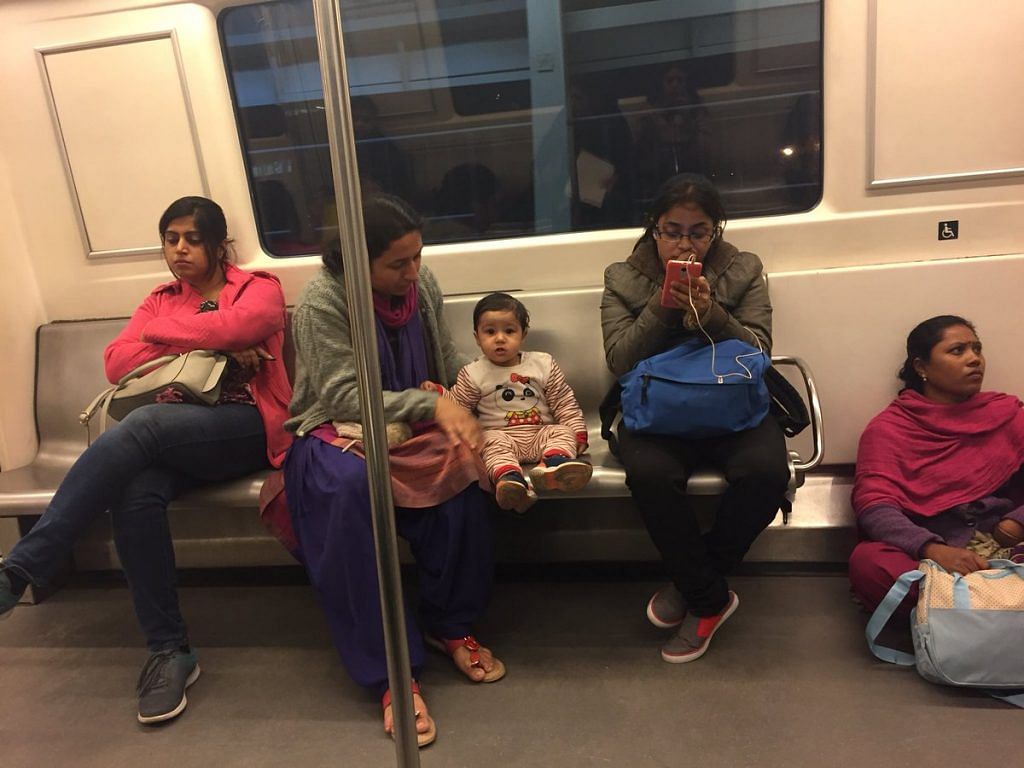ThePrint Reporter Sanya Dhingra tweeted a picture on 20 January which showed a woman and her child sitting on seats in the Delhi Metro while the child’s nanny sat on the floor with the caption “caste/class discrimination can be space-agnostic”.
Subsequently, ThePrint Editor-in-Chief Shekhar Gupta wrote an opinion piece saying, “in no other urban Indian situation does class inequality show up as starkly as in employer-domestic worker”.
Responding to the picture and the article, the woman with the child shared her side of the story, accusing the reporter of ‘taking advantage of (their) situation’. ThePrint sought the woman’s permission to publish her version with the response of its reporter but the woman insisted she would allow that only if the reporter apologised first.
Sanya Dhingra responds:
Over the last 24 hours, my attempt to highlight class discrimination as a space-agnostic phenomenon has been hailed as a classic example of unethical, click-baity journalism, or even worse, a cheap publicity stunt. It was none of this.
What happened
I boarded the metro on Saturday evening from the Chhatarpur station along with a friend. We were busy chatting until we noticed this woman, the child’s mother, take some things from the bags kept in front of the nanny – until then, we hadn’t realised that the two were, in fact, travelling together. The child and the mother were sitting on the seats, as the photograph shows, while the nanny sat on the floor with three seemingly heavy bags around her. My friend and I immediately pointed out the somewhat awkward seating arrangement to each other. Why was the nanny sitting on the floor when there were at least five-six empty seats in the compartment?
But this was just a question in our heads. One couldn’t be presumptuous, so I decided to ask the woman sitting on the floor why she did not take one of the seats. As opposed to what the woman with the child has recounted in her statement, the nanny did not answer the question.
“Our nanny, who is a very nice and simple lady, told her that she is comfortable there but since Ms. Dhingra kept staring at her, I told her that we are about to get down and we are with lots of luggage so we are ok, thanks for asking,” the woman has written.
In reality, though, the nanny looked at me blankly for a second, and the mother promptly jumped in to answer on her behalf. She was the one to tell me that the nanny is comfortable, and not the nanny to whom my question was addressed.
“When we boarded the metro, there were no seats, so she sat there. She’s comfortable, she likes it that way,” she said, in a very friendly tone. The nanny continued to look blankly. That was the end of our exchange. Soon all four of us got off at the same station.
What compelled to call it out as discrimination
It’s not my contention that the mother forcibly made the nanny sit on the floor, and comfortably plonked herself and her child on the seats. She, in fact, says in her statement that she too was sitting on the floor earlier – a claim I cannot verify or deny because I boarded the train later.
But the behalf-ism is what was telling for me. Why did she defensively jump in to respond on the nanny’s behalf? How can an employer be the spokesperson for their employee’s comfort and what they like? How are they in a better position than their employee to say what makes them happy or comfortable?
In her response, she has rightly pointed out that a lot of us sit on the floor of the metro when there are no seats. But here’s what we do immediately when there is a seat – we get up and take it. The nanny did no such thing. She was, as the woman – an AIIMS doctor – insists, “comfortable” on the floor. But I would for a moment urge the readers to imagine a situation wherein the nanny took a seat on the train, and the mother and the child sat on the floor. Hard to imagine, isn’t it?
Internalising ‘mild’ forms of discrimination
The woman in her statement says that ThePrint has irresponsibly clubbed her situation with “harsh cases of ‘servant exploitation’”. But could we for a moment reconfigure our minds to not think of cases of exploitation as ‘mild’ or ‘harsh’, but call out discrimination and hierarchy no matter how “mild” it is?
This picture and the tweet were not just about the woman or her child or her nanny. It was about all of us and our collective internalisation of segregation, discrimination, exploitation of those who work for us – who we happily give euphemistic names to and call “helps”, but cringe every time they enter our homes with slippers, use our bathrooms, or eat in the same utensils as us.
I refused to apologise or take the picture down when contacted by the doctor because the picture was shot as a commentary on our blinding privileged morality as it tells an important, fully factual story entirely in public interest. I and my editors fully stand by it.
